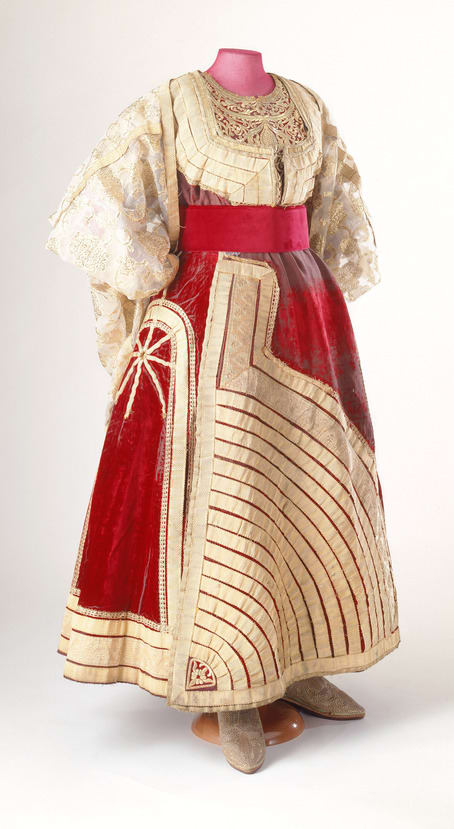
- Object Name:
- Marriage Dress
- Title:
- The Grand Costume (El-keswa el-kbira)
- Place Made:
- Marrakesh or Rabat, Morocco
- Date:
- late 19th century
- Medium:
- Skirt: silk velvet with gold metallic ribbon and passementerie; lining: polished cotton; bodice: silk velvet with gilt metallic embroidery, leather; sleeves: transparent silk chiffon with gold brocade
- Dimensions:
- Skirt: 39 3/8 × 118 1/8 in. (99.9 × 300.1 cm) Waistcoat: 23 5/8 × 24 3/4 in. (59.9 × 62.9 cm)
- Credit Line:
- Purchase: Judaica Acquisitions Committee Fund
- Accession Number:
- 1993-195a-e
Not On View
This nearly complete Grand Costume consists of a floor-length wraparound skirt (zeltita) of silk velvet embroidered with gold metallic threads, a plastron, or bodice, and a gombaz, or waistcoat, of the same materials and similarly embroidered. The diaphanous, billowing sleeves (kmam), which are separate from the costume, are made of striped silk embroidered with gold threads. The Grand Costume was worn by brides during the henna ceremony, when patterns in henna were applied to the bride to bring good luck before the actual marriage, and was later worn on festive occasions. This ensemble was made for Mas'uda, the bride of David Ohaion of Marrakech, in the late nineteenth century, and was worn by her descendants into the twentieth century.
For a number of reasons, the keswa el-kbira is thought to have been brought to Morocco by Jews who left Spain. The character of the Grand Costume, usually made of a rich, dark velvet adorned with gold ribbon and embroidery, and having separate sleeves, is reminiscent of late medieval Spanish garb, while the elaborate ceremony for dressing the bride before the henna ceremony is accompanied by songs and poems in Spanish. Further, this type of wedding dress is limited to Moroccan cities settled by Jews from Spain after the persecutions of 1391 and the Expulsion of 1492.
The impressive appearance of the keswa el-kbira made it a favorite subject for European writers and painters who came to Morocco. Delacroix, who visited in the 1820s, is but one example of an artist who depicted it several times.
For a number of reasons, the keswa el-kbira is thought to have been brought to Morocco by Jews who left Spain. The character of the Grand Costume, usually made of a rich, dark velvet adorned with gold ribbon and embroidery, and having separate sleeves, is reminiscent of late medieval Spanish garb, while the elaborate ceremony for dressing the bride before the henna ceremony is accompanied by songs and poems in Spanish. Further, this type of wedding dress is limited to Moroccan cities settled by Jews from Spain after the persecutions of 1391 and the Expulsion of 1492.
The impressive appearance of the keswa el-kbira made it a favorite subject for European writers and painters who came to Morocco. Delacroix, who visited in the 1820s, is but one example of an artist who depicted it several times.
Information may change as a result of ongoing research.